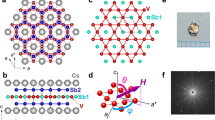Abstract
ADOPTING the simple Bom model for an alkali halide crystal, in which the ions are regarded as held in their respective positions by the electrostatic and the repulsion interactions between the ions, one may readily calculate the velocities of propagation v of long acoustic waves of wave-length λ along the principal directions [100], [110] and [111], and hence along any direction, in the crystal:  where m1 and m2 are the masses of the two ions, 2πΔ1n/λ denotes the difference in phase of the acoustic wave at any two ions 1 and n, and σn denotes summation over all the ions, except 1, in the crystal. (If D is the distance up to which the electrostatic interactions remain significant, λ is regarded as sufficiently large in comparison with D that cos(2πD/λ) can be put equal to 1 − ½(2πD/λ)2.)
where m1 and m2 are the masses of the two ions, 2πΔ1n/λ denotes the difference in phase of the acoustic wave at any two ions 1 and n, and σn denotes summation over all the ions, except 1, in the crystal. (If D is the distance up to which the electrostatic interactions remain significant, λ is regarded as sufficiently large in comparison with D that cos(2πD/λ) can be put equal to 1 − ½(2πD/λ)2.)  where ψ(R1n) is the interaction energy between the two ions 1 and n, separated by a distance R1n, and ψ′ and ψ″ are its differential coefficients with respect to R1n at its equilibrium value R1n0. Q is the cosine of the angle between R1n0 and the direction of displacement of the ions under the acoustic wave. Since the values of v2 for different directions of propagation and corresponding directions of displacement are also known in terms of the elastic constants c11, c12 and c44, we obtain, by comparing them with the values obtained from (1), expressions for the elastic constants in terms of the interactions between the ions. We shall denote by ɛ11, ɛ12, ɛ44 the contributions to C11, c12, c44 respectively from the electrostatic interactions, which are of long range, and by ρ11, ρ12, ρ44 the contributions from repulsion interactions, which are assumed to fall exponentially with the increase in the distance of separation of the interacting ions. In view of the short range of these repulsion interactions, we regard them as confined to the immediate neighbours only.
where ψ(R1n) is the interaction energy between the two ions 1 and n, separated by a distance R1n, and ψ′ and ψ″ are its differential coefficients with respect to R1n at its equilibrium value R1n0. Q is the cosine of the angle between R1n0 and the direction of displacement of the ions under the acoustic wave. Since the values of v2 for different directions of propagation and corresponding directions of displacement are also known in terms of the elastic constants c11, c12 and c44, we obtain, by comparing them with the values obtained from (1), expressions for the elastic constants in terms of the interactions between the ions. We shall denote by ɛ11, ɛ12, ɛ44 the contributions to C11, c12, c44 respectively from the electrostatic interactions, which are of long range, and by ρ11, ρ12, ρ44 the contributions from repulsion interactions, which are assumed to fall exponentially with the increase in the distance of separation of the interacting ions. In view of the short range of these repulsion interactions, we regard them as confined to the immediate neighbours only.
This is a preview of subscription content, access via your institution
Access options
Subscribe to this journal
Receive 51 print issues and online access
$199.00 per year
only $3.90 per issue
Buy this article
- Purchase on Springer Link
- Instant access to full article PDF
Prices may be subject to local taxes which are calculated during checkout
Similar content being viewed by others
References
Löwdin, Per-Olov, “A Theoretical Investigation into some Properties of Ionic Crystals”, 47 (Dissertation, Uppsala, 1948).
Kellermann, E. W., Phil. Trans. Roy. Soc., A, 238, 513 (1940).
Author information
Authors and Affiliations
Rights and permissions
About this article
Cite this article
KRISHNAN, K., ROY, S. Elastic Constants of Alkali Halide Crystals. Nature 168, 869–870 (1951). https://doi.org/10.1038/168869a0
Issue Date:
DOI: https://doi.org/10.1038/168869a0
Comments
By submitting a comment you agree to abide by our Terms and Community Guidelines. If you find something abusive or that does not comply with our terms or guidelines please flag it as inappropriate.



